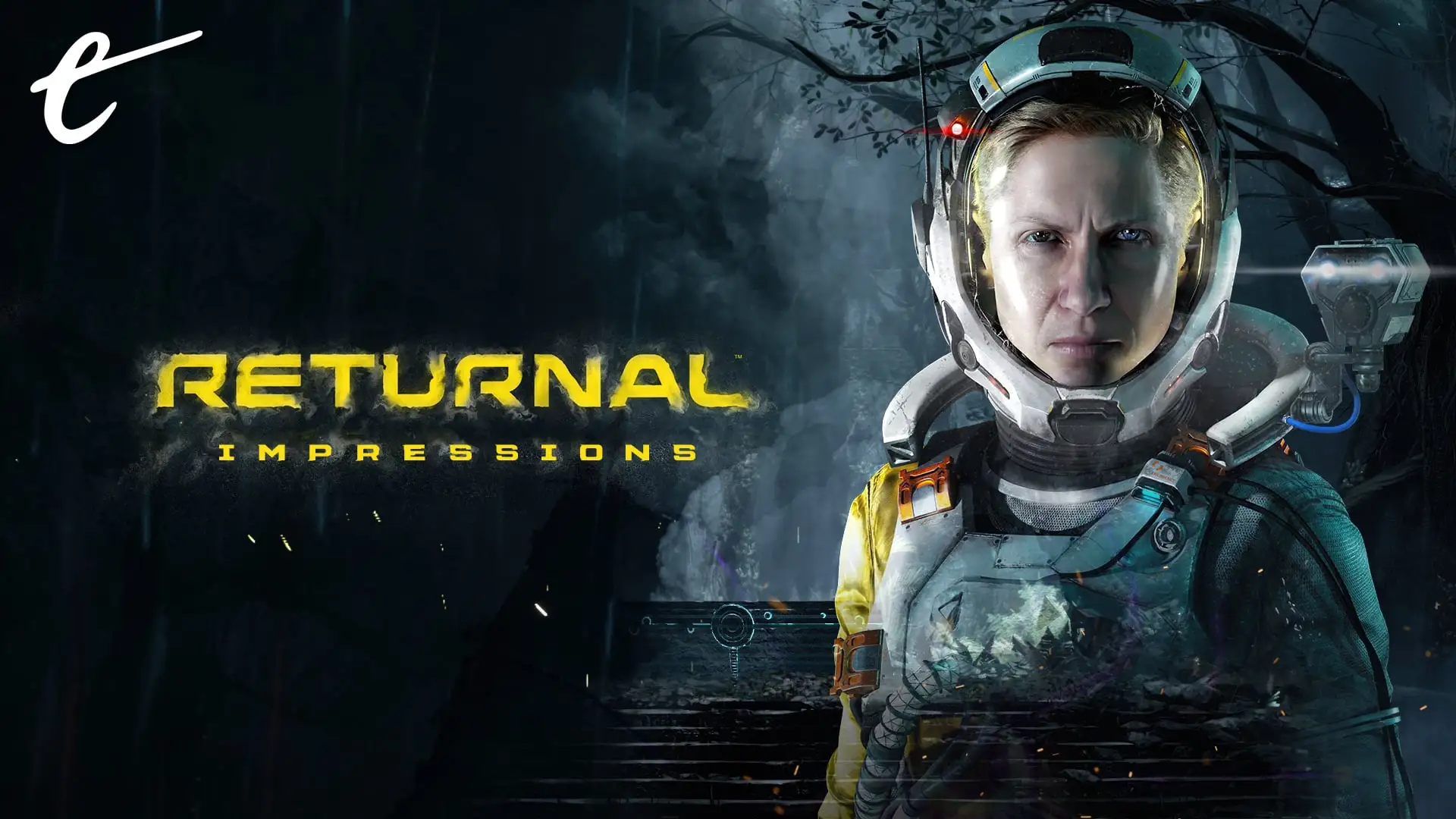Finnish development studio, Housemarque, is known for its frantic, twin-stick, arcade shooters. Titles such as Super Stardust HD, Dead Nation, and Resogun will immediately pop into the heads of PlayStation fans. With Returnal, Housemarque takes an H.R. Giger-inspired setting and aims to tailor their patented gameplay into a AAA roguelike. They wonderfully blend “bullet hell” infused gunfights with Metroidvania-style progression to deliver an overall great product to the PlayStation 5. While there are some bumps along the road, Returnal is a fantastic extension of the intense gameplay fans have come to love with Housemarque’s signature style.
Story

The player takes on the role of Selene, an astronaut who is following a mysterious signal known as “White Shadow” into a dark, unknown world. Her ship crashes onto the remote planet and thus begins the cycle. As Selene explores the alien world, she discovers that she is trapped in a cycle of every death. With each death the world shifts and changes. Selene slowly comes to grips with her situation as she pushes deeper into the various biomes (levels). I’ve finished playing through Act 1 making it to Biome 5 and I’m thoroughly on the hook when it comes to Selene’s story and why she came to this place. Returnal offers plenty of mystery and intrigue to keep players invested and discovering more about the ancient planet only adds to the incredible setting in which she finds herself.
It’s unusual for Housemarque to focus this much on narrative. Indeed, while many of their past games had a simple story to compliment the arcade action, none of them had the level of focus and quality that you get here in Returnal. I had reservations about Housemarque pulling this type of move in fear that gameplay would suffer. I’m happy to report that the overall experience isn’t detracted in any way and the blending of narrative and gameplay is quite noteworthy when you see just how similar Returnal is to Housemarque’s past games. Everything from the horror setting to the stellar voice work by actress, Jane Perry, are all welcome additions to the tried and true Housemarque formula.
Gameplay

Housemarque has delivered some of the very best gameplay experiences in the modern gaming era. The aforementioned titles such as Resogun stand out as hallmarks in the PlayStation pantheon. With Returnal featuring a traditional 3rd person, over-the-shoulder camera perspective, many wondered if the gameplay experience could match the pedigree that Housemarque was known for. It takes several deaths to realize it, but Returnal is a beautiful blending of Housemarque’s proven gameplay style with that of a 3rd person, roguelike, Metroidvania.
Gunplay is a treat in Returnal. Weapons first come with traditional archetypes such as a pistol or shotgun, but each subsequent weapon unlock keeps things fun and interesting. This is largely thanks to the properties and alt-fire for each gun. As you use a particular gun, you’ll permanently unlock attributes such as a slugshot for the shotgun or added homing fire for the pistol. Lightly pressing L2 lets you aim down the sites, but squeeze through the pressure of the DualSense’s adaptive triggers and you’ll engage that gun’s alt-fire, which can be used to deal devastating blows. Enemies present a nice challenge (especially early on), but as with most roguelikes, there’s always a small sense of permanence that carries over allowing you to turn the tables on that enemy that once posed such a threat. Many enemies, and bosses in particular, are relentless with their attacks and deliver that “bullet hell” experience that Housemarque has perfected.
When not running and gunning, the game slows down quite a bit to allow for exploration and artifact hunting. Artifacts are single-run augments that give you some sort of buff, such as improved auto-heal while on low health. Exploring the environments also yields parasites which are a buff/debuff mixture. Attaching a parasite to Selene could be the difference between beating a boss or getting wrecked by one, so careful consideration of that run’s loadout is crucial. There are a host of other objects and power-ups that the player can interact with in Returnal. While much of it is straightforward, there’s a Souls-like quality to some of the obtuseness found with certain objects (I’m looking at you, Reconstructor).
With all that said, Returnal is not without faults. In early builds (1.3.4 and earlier) I hit several run-ending bugs due to doors not opening. Additionally, there would be times when I couldn’t pick up or interact with an object. Thankfully, Housemarque has been quick to respond and has seemingly patched out the run-breaking bugs. However, there’s a larger issue at hand that is my #1 gripe with Returnal. Each run has the potential to be well over 2 hours long sometimes bleeding into 4-hour territory. This might not sound too bad, but the game offers no native save/quit support if you’re in the middle of a run. Upon booting up for the first time the game tells you that the only way to save a run and return to it is by placing the PS5 into rest mode. If the game application is closed or if your PS5 power cycles, then your current run is lost. While I enjoy the length a run can take, having to save a run this way is less than ideal, especially when I have others in my home who want to play on the PS5 and can’t because my Returnal run is in rest mode.
Audio/Visuals

Returnal is only the second Sony Studios PS5 exclusive, so there was a burden placed on Housemarque to truly deliver the goods in terms of taking full advantage of the new hardware. Thankfully I can say that Returnal is quite the feast for not only the eyes and ears but also the hands. I’ve already mentioned Returnal’s utilization of the DualSense controller. Along with the adaptive triggers, the controller’s haptics are incredible and go a long way in making Returnal feel like one of the first true next-gen experiences. Whether it’s the pitter-patter of the rain on Selene’s suit, fast traveling, or shooting a powerful alt-fire, the DualSense’s haptics delivers the best controller experience since Astro’s Playroom.
Recently gamers have enjoyed choosing between a performance or quality mode for graphics with one emphasizing frame rate and the other emphasizing high resolution. However, with Returnal we’re only given one mode which presents the game in a dynamic 4K resolution running at 60FPS with ray-tracing on. I’m no FPS snob, but I didn’t feel any noticeable performance hiccups during my 30 hours of playtime. Action always felt smooth and environments are a wonder to behold. I’d be remiss if I didn’t mention the fast-travel system and general SSD utilization. Selene can near-instantly be teleported from one end of the map to the other thanks to the streamlined PS5 SSD. It’s a small thing to mention here, but makes all the difference in the world while in the middle of a long run.
Closing Thoughts
With Returnal, Housemarque has delivered the essence of their core gameplay via a 3rd-person shooter. This is the single best praise I can heap on Returnal. There was genuine worry from Housemarque fans fearing that Returnal was the first step in moving away from that tried and true formula. Not only have they successfully transported that patented gameplay feels into a new genre, but they’ve also added an intriguing story, brought to life the most vivid world they’ve ever crafted, and implemented the best usage of the DualSense controller to date. While I still need to roll the credits (and get that platinum!) for Returnal, I can say with confidence that it’s one of PS5’s best games and is worth picking up. Yes, even at $70.




Leave a Comment